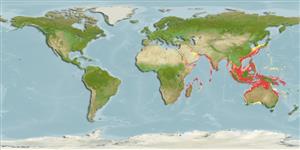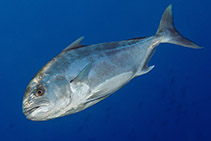Seriolina nigrofasciata (Rüppell, 1829)
Blackbanded trevally
Add your observation in Fish Watcher
| Native range | All suitable habitat | Point map | Year 2050 |

|
| This map was computer-generated and has not yet been reviewed. |
| Seriolina nigrofasciata AquaMaps Data sources: GBIF OBIS |
Upload your photos and videos
Pictures | Google imageSeriolina nigrofasciata
Picture by Greenfield, J.
Pictures | Google imageSeriolina nigrofasciata
Picture by Greenfield, J.
Thailand country information
Common names:
[No common name]
Occurrence: native
Salinity: marine
Abundance: | Ref:
Importance: minor commercial | Ref:
Aquaculture: | Ref:
Regulations: | Ref:
Uses: no uses
Comments: Known from Ko Sichang (Chon Buri), Gulf of Thailand, Songkhla and Andaman Sea (Ref. 37773). Also Ref. 3287.
National Checklist:
Country Information: https://www.cia.gov/library/publications/resources/the-world-factbook/geos/th.html
National Fisheries Authority:
Occurrences: Occurrences Point map
Main Ref: Monkolprasit, S., S. Sontirat, S. Vimollohakarn and T. Songsirikul, 1997
National Database:
Occurrence: native
Salinity: marine
Abundance: | Ref:
Importance: minor commercial | Ref:
Aquaculture: | Ref:
Regulations: | Ref:
Uses: no uses
Comments: Known from Ko Sichang (Chon Buri), Gulf of Thailand, Songkhla and Andaman Sea (Ref. 37773). Also Ref. 3287.
National Checklist:
Country Information: https://www.cia.gov/library/publications/resources/the-world-factbook/geos/th.html
National Fisheries Authority:
Occurrences: Occurrences Point map
Main Ref: Monkolprasit, S., S. Sontirat, S. Vimollohakarn and T. Songsirikul, 1997
National Database:
Common names from other countries
Classification / Names Common names | Synonyms | Catalog of Fishes(genus, species) | ITIS | CoL | WoRMS | Cloffa
Teleostei (teleosts) > Carangiformes (Jacks) > Carangidae (Jacks and pompanos) > Naucratinae
Etymology: Seriolina: Latin word diminutive with the meaning of a large earthenware pot (Ref. 45335).
More on author: Rüppell.
Etymology: Seriolina: Latin word diminutive with the meaning of a large earthenware pot (Ref. 45335).
More on author: Rüppell.
Environment: milieu / climate zone / depth range / distribution range Ecology
Marine; brackish; reef-associated; depth range 20 - 150 m (Ref. 30573). Tropical; 38°N - 35°S, 20°E - 163°E
Distribution Countries | FAO areas | Ecosystems | Occurrences | Point map | Introductions | Faunafri
Indo-West Pacific: Red Sea and East Africa to Japan, Australia and Solomon Island. Southeast Atlantic: southeast coast of South Africa (Ref. 3197).
Size / Weight / Age
Maturity: Lm ? range ? - ? cm
Max length : 77.5 cm TL male/unsexed; (Ref. 30504); common length : 50.0 cm TL male/unsexed; (Ref. 5450); max. published weight: 5.2 kg (Ref. 3287)
Max length : 77.5 cm TL male/unsexed; (Ref. 30504); common length : 50.0 cm TL male/unsexed; (Ref. 5450); max. published weight: 5.2 kg (Ref. 3287)
Short description Identification keys | Morphology | Morphometrics
Dorsal spines (total): 8 - 9; Dorsal soft rays (total): 30 - 37; Anal spines: 2; Anal soft rays: 15 - 18. Color bluish grey to black dorsally, white to dusky below; 5-7 dark oblique bands or blotches on young disappear with age. Posterior spines of dorsal fin minute or embedded in large adults; first anal spine usually embedded. Gill rakers are mostly rudiments. Grooves of caudal peduncle present dorsally and ventrally. Maxilla reaching below rear margin of the eyes.
Mainly in offshore reefs on the continental shelf (Ref. 30573, 48635), on rocky bottoms (Ref. 11230). Non-schooling. Juveniles under weed rafts and adults are sometimes seen with the large planktivores such as whale sharks (Ref. 48635). Adults feed on demersal fishes, cephalopods, and shrimp (Ref. 11441). Excellent food fish (Ref. 3197); marketed fresh and dried salted (Ref. 3287).
Life cycle and mating behavior Maturity | Reproduction | Spawning | Eggs | Fecundity | Larvae
Main reference
Upload your references | References | Coordinator : Smith-Vaniz, William F. | Collaborators
Paxton, J.R., D.F. Hoese, G.R. Allen and J.E. Hanley, 1989. Pisces. Petromyzontidae to Carangidae. Zoological Catalogue of Australia, Vol. 7. Australian Government Publishing Service, Canberra, 665 p. (Ref. 7300)
IUCN Red List Status (Ref. 130435: Version 2024-2)
Least Concern (LC) ; Date assessed: 09 March 2015
Threat to humans
Harmless
Human uses
Fisheries: minor commercial; gamefish: yes
FAO(Fisheries: production; publication : search) | FishSource | Sea Around Us
More information
Population dynamics
Growth parameters
Max. ages / sizes
Length-weight rel.
Length-length rel.
Length-frequencies
Mass conversion
Recruitment
Abundance
Growth parameters
Max. ages / sizes
Length-weight rel.
Length-length rel.
Length-frequencies
Mass conversion
Recruitment
Abundance
Life cycle
Reproduction
Maturity
Fecundity
Spawning
Spawning aggregations
Eggs
Egg development
Larvae
Larval dynamics
Reproduction
Maturity
Fecundity
Spawning
Spawning aggregations
Eggs
Egg development
Larvae
Larval dynamics
Physiology
Body composition
Nutrients
Oxygen consumption
Swimming type
Swimming speed
Visual pigments
Fish sound
Diseases & Parasites
Toxicity (LC50s)
Body composition
Nutrients
Oxygen consumption
Swimming type
Swimming speed
Visual pigments
Fish sound
Diseases & Parasites
Toxicity (LC50s)
Human related
Aquaculture systems
Aquaculture profiles
Strains
Ciguatera cases
Stamps, coins, misc.
Aquaculture systems
Aquaculture profiles
Strains
Ciguatera cases
Stamps, coins, misc.
Tools
Bio-Quiz | E-book | Field guide | Identification keys | Length-frequency wizard | Life-history tool | Point map | Classification Tree
| Catch-MSY |
Special reports
Download XML
Internet sources
Aquatic Commons | BHL | Cloffa | BOLDSystems | Websites from users | Check FishWatcher | CISTI | Catalog of Fishes(genus, species) | DiscoverLife | ECOTOX | Faunafri | Fishtrace | GenBank(genome, nucleotide) | GloBI | GOBASE | | Google Books | Google Scholar | Google | IGFA World Record | MitoFish | National databases | Otolith Atlas of Taiwan Fishes | PubMed | Reef Life Survey | Scirus | SeaLifeBase | Tree of Life | Wikipedia(Go, Search) | World Records Freshwater Fishing | Zoological Record
Estimates based on models
Preferred temperature (Ref. 115969): 21.9 - 28.3, mean 27 (based on 911 cells).
Phylogenetic diversity index (Ref. 82804): PD50 = 1.0000 [Uniqueness, from 0.5 = low to 2.0 = high].
Bayesian length-weight: a=0.02344 (0.01170 - 0.04697), b=2.93 (2.75 - 3.11), in cm Total Length, based on LWR estimates for this species & (Sub)family-body (Ref. 93245).
Trophic level (Ref. 69278): 4.2 ±0.57 se; based on food items.
Resilience (Ref. 120179): Medium, minimum population doubling time 1.4 - 4.4 years (Assuming tm=2-4).
Fishing Vulnerability (Ref. 59153): Moderate to high vulnerability (51 of 100).
Climate Vulnerability (Ref. 125649): High vulnerability (61 of 100).




